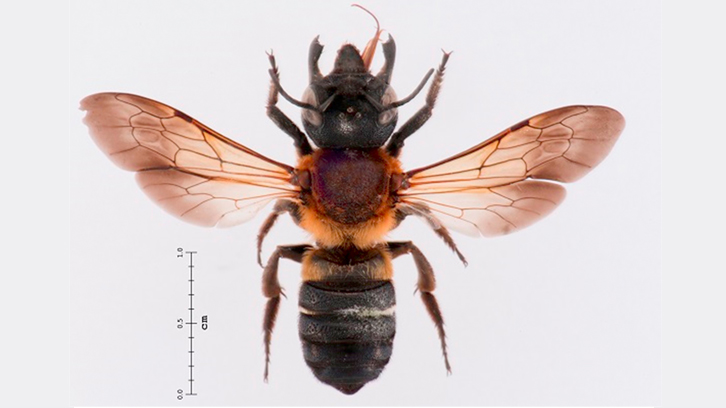The giant resin bee will continue to spread across Europe

Researchers from the UAB and CREAF participated in a study on the potential of the invasion of the Megachile sculpturalis bee in Europe, the causes of its expansion and the influence of climate change in this process. The results show a vertiginous rate of expansion, due to globalisation and associated human activities. Precise monitoring is key to generating more scientific knowledge and correctly assessing its status as an invasive alien species.
The giant resin bee (Megachile sculpturalis) is the first exotic bee reported in Europe. In 2018 it was detected for the first time in the Iberian Peninsula. It is native to the Eastern Asia, and like most bee species (in Europe alone there are about 2,000) it is solitary: all the females reproduce and found their own nest. In the case of M. sculpturalis, the females make their nests in holes they find or make in the trunks of living or dead trees. Despite its large size -it can exceed 2 cm in length (see image),- it is not aggressive.
Since the first record, the bee has colonized a large part of the Central Europe at a fast way, multiplying its records by ten in recent years. For that reason, CREAF researchers participated in a study led by the University of Natural Resources and Life Sciences of Vienna (BOKU) to find the invasion potential of M. sculpturalis in Europe, the causes of its expansion, and the influence of climate change on its invasion process.
The results show, on the one hand, that the invasion process is incipient, since M. sculpturalis has only colonized a small part (25%) of the territory with invasion potential, based on its ecological requirements. For example, within the Iberian Peninsula, the presence of M. sculpturalis is concentrated on the Eastern coast, although it is expected that the bee will soon reach other regions like the Cantabrian basin.
On the other hand, the study shows that the most important factors that explain the arrival of M. sculpturalis, apart from the climatic ones (the climate must be similar to its region of origin), are anthropic: ports, communication, and densely populated cities. The giant resin bee arrived in Europe, most likely, by maritime transport of wood (with some nests inside), and once here the roads served to disperse the species. Records of occurrences of M. sculpturalis are concentrated in urban areas, where it is able to use human constructions to nest (for example, brick holes), and extracts pollen, almost exclusively, from some exotic ornamental trees.
Finally, we have found that climate change is not going to favour the potential area of invasion of this bee species in Europe, but it can modify its distribution: a lower presence is expected in the Mediterranean regions and a greater presence in the Central and Norrthern Europe (for example, in the British Isles).
This study shows that globalization is decisive in the process of biological invasions, which are one of the main causes of biodiversity loss in the world. Although the ecological and human damage that the giant resin bee can cause is limited, it is necessary to monitor the species to generate more scientific knowledge and correctly assess its status as an invasive alien species. In this sense, citizen science databases have been crucial for the development of this study.
(1) CREAF
(2) Department of Animal Biology, Plant Biology and Ecology, Universitat Autònoma de Barcelona
References
Lanner et al. On the road: Anthropogenic factors drive the invasion risk of a wild solitary bee species (2022). Science of the Total Environment 827(25): 154246. https://doi.org/10.1016/j.scitotenv.2022.154246


